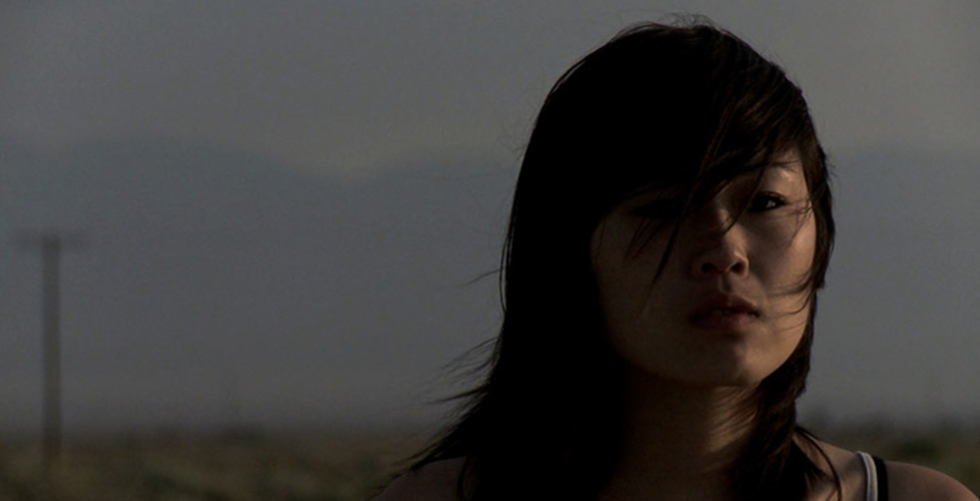
BY ZACHARY WIGON |
Found in Translation: Littlerock
The "Best Movie Not Playing at a Theater Near You" opens Friday: Littlerock is the latest low-budget, high-aesthetic movie to display how small-budget cinema can still be formally ambitious.


Photo © 2011 Variance Films, Inc.
The independent film world is seeing an interesting trend right now, one which has yet to be named but deserves some recognition. In 2007-2008, the term “mumblecore” became a quick way to recognize independent films made for budgets of close to zilch that still managed to carry a three-act story and present some interesting characters. In short, they were the first ultra-ultra-low-budget movies made by totally unknown filmmakers to be able to garner national (and in some cases international) distribution.
Flash-forward to 2011, and “mumblecore” is an oft-loathed term, as well as (to a lesser degree) genre of film. Yet filmmakers continue to persist in their quest to make significant feature films for next to nothing. The latest wave of low-budget filmmaking is currently differentiating itself from its mumblecore forebears by having significant aesthetic modes, while still being made for equally minute budgets. Films like Bellflower, The Myth of the American Sleepover, and Loren Cass are all solid examples, and the latest movie to enter the realm is Littlerock.
Director Mike Ott’s second feature—winner of the Gotham Award for Best Film Not Playing At A Theater Near You—is a quiet, lyrical mood piece set in the titular area of LA, a scenic, empty desert-scape. The story revolves around a young Japanese woman (Atsuko Okatsuka) who is on a California road trip with her brother (Rintaro Sawamoto); she decides to hang around the town of Littlerock while her brother goes off to sightsee, and in doing so strikes up unconventional friendships with a few of the townspeople. Combining a sparseness of scenery with minimalism of camerawork and dialogue (the protagonist does not speak English, and much of her Japanese is not subtitled), the film manages to evoke a very strong sense of style with nothing more than the simple tools at Ott’s disposal.
I recently sat down with Ott (named Someone to Watch at the 2011 Independent Spirit Awards) and lead actress/co-writer Okatsuka at the offices of the film’s distributor, Variance Films.

Photo © 2011 Variance Films, Inc.
Tribeca: So what are your backgrounds in film? How did the two of you come to team up on this film?
Mike Ott: I went to art school at CalArts. I did my first feature there, my thesis, which was called Analog Days. I toured around with that a bit, and met a lot of these producer types while it played around—people who wanted to make a film with me. And it was the biggest waste of time; I don’t even know if they really could have made a film. So after about two years, I just decided to raise money and make a movie on my own. That’s about the time I met Atsuko.
Atsuko Okatsuka: I took a class with Mike. He was teaching filmmaking. And I guess that was right around when he was like, “Fuck it.”
Mike Ott: Yeah. Actually, a cinematographer and I were going out and shooting landscapes in Littlerock, and we had Atsuko come out because we needed a stand-in, someone to be in the images.
Tribeca: It’s interesting—when you work on a level like this, budget-wise, you obviously take certain aesthetic considerations into account in a much bigger way. Like, where you set the film is going to contribute much more to your film’s style when you don’t have much else to play with. How did you decide to shoot in Littlerock?

Photo © 2011 Variance Films, Inc.
Mike Ott: My friend was doing entry-tier reviews for Sundance—coverage of films—so I would go there and watch these submissions, and for me it was like, better than going to film school. You could see what made a film look cheap. Which was sometimes someone trying to make a big-budget movie, which they couldn’t do, or a movie with no extras, like, the two actors are in a restaurant and there’s no one else. So we felt like with Littlerock we could shoot in a landscape that lent production value—going out to these dilapidated abandoned houses with crazy backgrounds and stuff. You can’t get that in a city.
We also stole a lot of French New Wave techniques, like taking the characters to a real parade and just shooting that. It’s something we thought about: how can you make a movie with no money and make sure it doesn’t look like that?
Tribeca: This kind of “mumblecore” thing started a while back, and it crested and faded. People are still making films at the same budget levels as those films, but now filmmakers are really expected to make low-budget films aesthetically interesting. Bellflower’s another example. Were you grappling with that expectation?
Mike Ott: Yeah. For me, I loathe mumblecore films; they’re just the most, like, slit my wrists, you know? I met Matt Porterfield, who made Putty Hill, in 2006, and we bonded over the feeling that mumblecore—not that the people making the films don’t know about cinema—but that the films had a kind of lack of knowledge of cinema. So I wasn’t interested in making something with a handheld video camera about people pontificating. I find it really uninteresting. So, how to make something somewhat cinematic—shooting at magic hour, pay homage to films we were inspired by—was something we tried to do.

Photo © 2011 Variance Films, Inc.
Tribeca: There were some really nice sunspots in the photography.
Mike Ott: We had the luxury of going out and doing test shoots, me and the DP, and Atsuko and Cory [Zacharia, another actor in the film], and we would go out and shoot. Our days of shooting were really short: we’d typically start at 5 and go till 8, to get some of the magic hour stuff.
Tribeca: Atsuko, the role you play is obviously really non-verbal. What’s it like to be playing a scene where you don’t have the ability to fall back on the comfort of dialogue to communicate your character’s interior state?
Atsuko Okatsuka: Well, I guess you do a lot of listening. Maybe that’s a given, because I say so little. To react and to have feelings about what’s being said are important. The challenge is knowing what people are saying. Especially when I was doing scenes with Cory, he would be cracking up the whole set, and I would have to keep a straight face because my character doesn’t know what he’s saying. Plus he gets so close to you. That was a big challenge.

Photo © 2011 Variance Films, Inc.
Tribeca: It must be very difficult, a difficult balancing act, because you know what he’s saying, but you have to act like you don’t know what he’s saying, but at the same time your character does have a sort of sense, a rough idea of what’s being said.
Atsuko Okatsuka: A little bit, yeah. I was trying to remember, when I first came to the States and didn’t understand English, how it came to me. Eventually you figure out what things are—like. you figure out what a pen is, because every time someone picks it up, they say it’s a pen or something. For me to try to figure out when I actually understood what Cory was saying—for me to answer him—there were a lot of points of confusion and realization. I was doing a lot of thinking.
Mike Ott: There are a lot of things where you’re kind of responding to him in Japanese, roughly, it’s just not subtitled. I think that’s the interesting thing—you can communicate with people across languages.
Atsuko Okatsuka: Right. The answers and questions kind of match up.

Photo © 2011 Variance Films, Inc.
Tribeca: What about the work you did for crafting your character’s romantic relationship? How did you guys set that up?
Mike Ott: I felt like she falls in love with America, and Jordan [Brett L. Tinnes] is this kind of representation of America. There’s this quick shot we did where she wakes up, and he’s in the shower, and she’s lying in this bed—we made the sheets red, white, and blue, as if she just had sex with America. We wanted it to seem like this place that takes her in—America—but then this guy fucks her the first night, cheats on her, and all that. And he’s kind of trying to do what everyone’s trying to do. It’s like in When Harry Met Sally, when he says that any guy who’s talking to you is trying to fuck you.
Tribeca: What do you think that stems from? It’s true that a lot of the male characters are interested in her. Were you interested in her exotic-ness, her other-ness, in this setting?
Mike Ott: I think in a small town, any town where there’s a new girl, there’s new blood in the water. We cast a lot of townies in the movie, like in the party scene, and there are not a lot of beautiful girls roaming around Littlerock. Atsuko’s obviously beautiful, but even if she wasn’t, I think there would’ve been interest because she’s this new girl there. The fact that she’s a foreigner—maybe that makes them think that she’s an easier target.
Atsuko Okatsuka: I think it’s the newcomer syndrome. It’s like that everywhere in the world. People want to try something new. That’s why I fell in love with America too, I think.

Littlerock opens Friday, August 12, at Cinema Village in New York City. Find tickets.
Watch the trailer:
LiTTLEROCK Trailer from Small Form Films on Vimeo.